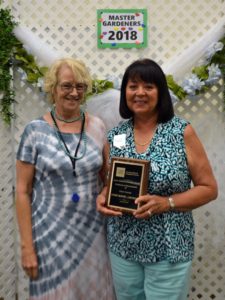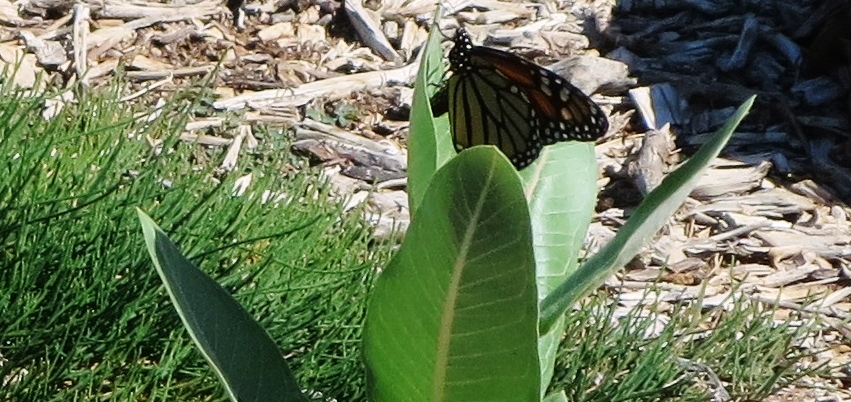Once upon a time, before the invasion of Europeans—with their cattle, horses, sheep, goats and plows—the dry, dusty place know as the American Southwest was covered in short- and medium-grass prairies, and water wasn’t rare. Wildlife abounded, including migrating monarch butterflies.
Every entomologist in Nevada knows that monarch butterflies don’t like Las Vegas. Since the city was founded, they ignore it on their long migrations, finding nothing there to support life. Never in the recorded history of the city have they ever bred there in the Spring.
But now they do once again, thanks to one woman.
A Master Gardener’s five-year quest to increase pollinators by planting and conducting research with 30 varieties of milkweed in the Las Vegas area is showing some restorative results. This spring brought the first ever recorded spring sighting of Western monarch butterflies laying eggs in Las Vegas. The eggs have since hatched, and 12 new butterflies were tagged and released on June 11, 2018.

Anne Marie Lardeau (r) receives the first Citizen Scientist Award from Coop. Extension Social Horticulture Specialist Angela O’Callaghan.
“There has never been a documented instance of reproduction in Las Vegas as part of the spring migration,” said Anne Marie Lardeau, a Master Gardener volunteer with University of Nevada Cooperative Extension, who is conducting the research. “We get them in the fall, but have never observed nor received reports of caterpillars in the spring before. Usually they ignore us, either just stopping to eat or simply flying over.”
Lardeau’s work has focused on the Western monarch’s attraction to milkweed plants, and the scarcity of the plants in the Las Vegas area. She says the butterflies migrate north from Mexico and California in the spring and back home in the fall, leaving their eggs only on milkweed plants along the route both directions.
However, the number of migratory butterflies is dwindling, milkweed is scarce, and the number of butterflies that stay in one place and have more diseases is growing.
Places to rest and nest:
Lardeau began her studies in 2014 when Extension faculty and staff discovered a rush milkweed plant that had been planted as a native plant example in the Botanical and Test Gardens at the Clark County Cooperative Extension Lifelong Learning Center.
At the time, Lardeau says researchers believed there were no monarch butterflies in Las Vegas, and the milkweed planters didn’t know the milkweed’s full potential. She and other Extension faculty and staff recognized the value of the plant in terms of attracting the butterflies, and began donating milkweed seeds and looking into growing more rush milkweed and other varieties.
Now, Cooperative Extension supports several butterfly habitats of milkweed and nectar plants in their botanical garden, including 480 milkweed plants, representing 30 varieties, including six native to Clark County, five international varieties and 19 Southwestern native varieties.
“We have the best collection of milkweed,” she said. “And now, we’re seeing a lot more monarch butterflies after thinking there weren’t any.”
Her goal is to determine which plants are the best for the pollinators, which ones will grow well in residential gardens in Las Vegas, and overall monarch preference: the milkweed varieties they prefer, the ones they settle for, and the ones they snub. Having a monarch choose a plant to lay eggs as part of the spring migration served as an exciting sign that her research is on the right track.
Sowing seeds and spreading wings:
However, Lardeau doesn’t want the milkweed and nectar plants to be limited to the now five butterfly habitats throughout the Botanical and Test Gardens. She also wants to see butterfly gardens in backyards and schools around Las Vegas.
“This is a joint community effort to increase availability of milkweed in the Las Vegas area,” she said. “We want to provide the public with advice on tried and effective ways to create butterfly gardens.”
She invited local residents to participate in the research project, providing them with free seeds from Extension’s milkweeds, instructions for planting and care, surveys to track plant success, and classes on how to build the gardens.
“Native milkweed seeds are either rare or expensive,” she said. “In addition, native milkweed is rare in the wild, and seeds cannot be collected on public land without a permit or on private land without owner permission. So, we’re really excited to make the seeds available for free.”
Lardeau warns against buying milkweed from anywhere, other than the Nevada Department of Forestry, as most are treated with pesticides, which will kill any caterpillars born on the plants.
Lardeau was recognized for her work in 2017, when she took home a Search for Excellence Award from the International Master Gardener Conference, being awarded Second Place in the Research category.
The University of Nevada Cooperative Extension’s Botanical and Test Gardens are at 8050 Paradise Road in Las Vegas. Free packets of milkweed seeds are available to visitors. The gardens, including the butterfly gardens, are open to the public, free of charge. Self-guided tours are available 8 a.m. – 4:30 p.m., Monday through Friday. From September to May, guided tours are offered at 10 a.m. on Fridays.
Photo of monarch laying eggs on milkweed by Anne Marie Lardeau / Cooperative Extension.
See Clark County Cooperative Extension Master Gardeners website.

